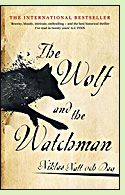The Wolf and the Watchman
by Niklas Natt Och Dag
Reviewed by Margaret Tomlinson

Set
in late eighteenth-century Sweden, The
Wolf and the Watchman is a tale of brutality, survival and hope.
Mickel
Cardell, a night watchman who lost his left arm in a disastrous naval battle,
has a sense of honor, a quick temper, and a wooden replacement arm both useful and dangerous in a fight. Cecil Winge is a lawyer with a sharp mind and
a history of being helpful to the police. He is dying of consumption and has a sense of honor. The characteristic the two men share is not in ample
supply in the Stockholm of their time, but it's the main reason they find
themselves reluctantly working together to find and bring to justice the killer
of a man whose partially decomposed body, missing arms, legs, tongue and eyes,
Cardell fishes out of a lake.
What
is justice? readers will wonder along the way, as a parade of evildoers prove
to have been as much victims as victimizers. An uncertain national government in
the year after King Gustav III's assassination does not help matters. Winge is
under pressure to find the murderer quickly and discreetly, because the head of
the police expects to be replaced shortly by an official more keen to enforce
censorship regulations than to catch killers.
Several
women are keys to solving the crime, and the novel moves backward to tell their stories, as well as others. Especially sympathetic is Anna Stina
Knapp, a young women who clings determinedly to every shred of hope she can muster
in a system as unjust and sadistic as the murderer Cardell and Winge are
hunting. Readers with the stomach to immerse themselves in a cruel and violent
setting will find The Wolf and the Watchman a gripping novel
with enough surprises and sudden reverses to keep them glued to the pages.
(2017 in the original Swedish, English translation 2019; 373 pages)
Other historical novels set in Sweden:
The Road to Jerusalem by Jan Guillou (1998), about a young Swede whose life is up-ended twice before he recognizes his destiny to become a Knight Templar; #1 in the Crusades trilogy. See review or more info at The Book Depository
In the Month of the Midnight Sun by Cecilia Ekbäck (2016), about a geologist who goes undercover for the Swedish government in 1856 to investigate killings by one of the nomadic Sami people in Lapland. More info
Memoirs of a Cavalier by Daniel Defoe (1720), a novel written in the form of a memoir by an English mercenary who fought in the armies of the Swedish King Gustavus Adolphus and the English King Charles I from 1632 to 1648 during the latter part of the Thirty Years War. More info
Nonfiction about the history of Sweden:
A Concise History of Sweden by Neil Kent (2008). More info
Charles XII and the Collapse of the Swedish Empire by R. Nisbet Bain (1895), about Sweden's ruler from 1697 to 1718. More info
Stockholm: A Cultural History by Tony Griffiths (2009). More info
Online:
Gustav IV Adolf of Sweden at Wikipedia
Back to Novels of the Eighteenth Century
Back to Directory of Book Reviews